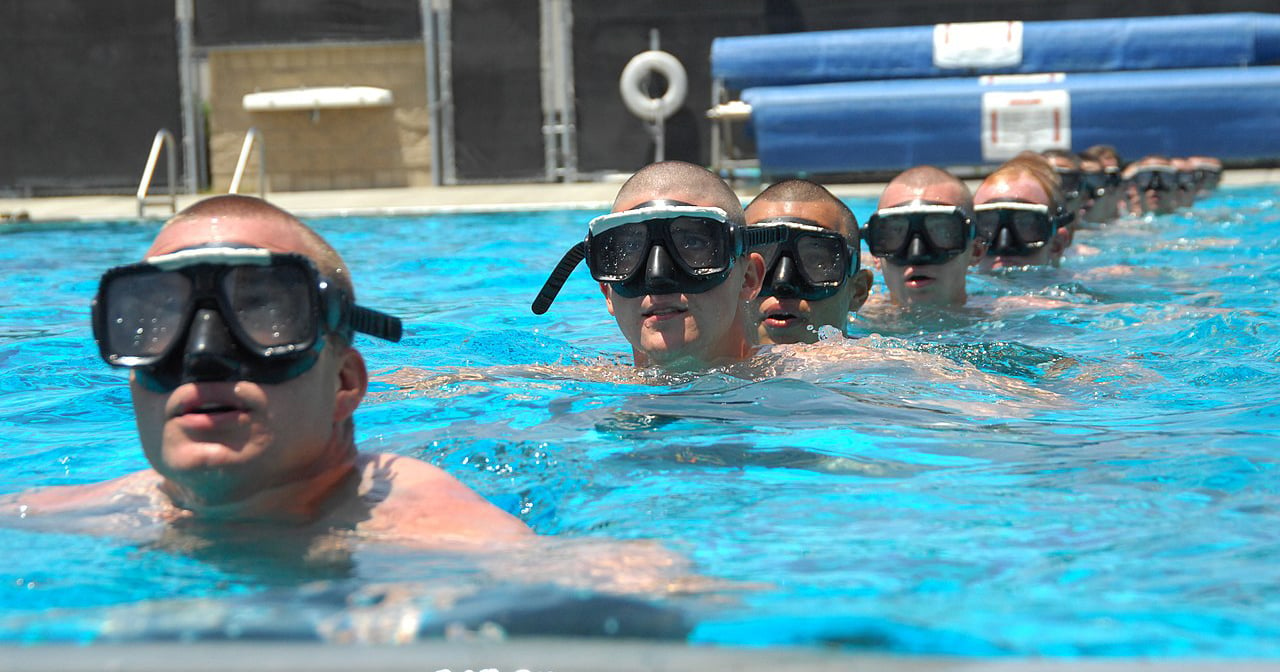Pool competency, referred to as “Pool Comp” in SEAL training, is one of the hardest tests to pass besides Hell Week. Pool Comp, like Hell Week, runs for a week (Hell Week goes for about a half day longer) and is known as the evolution responsible for the highest number of failures. The entire purpose of Pool Comp is to test SEAL candidates' competency underwater with SCUBA gear, and it was the one evolution I was really excited about.
I had learned to SCUBA dive at the age of 12 and had 10 years of diving experience by the time I started Pool Comp. I was confident I would pass this week of underwater “testing” which comes in the form of intense breath-holding under high levels of instructor harassment over roughly 20 minutes.
The final test occurred on Friday morning, and as one of the class leaders, I was required to test first. I entered the water confidently while my entire class was sitting down with their backs to the pool so they could not watch the “test.” After I swam down the 9-foot section, several instructors "attacked" me and simulated what it would be like to get rolled in a surf zone with pounding waves. Within 90 seconds, I received a tap on my head—the instructor’s signal to surface. Confused, I surfaced only to hear the lead instructor yell out, “Mills – you fail – out of the water – keep your back to the pool.”
I was stunned. I had no idea what I did wrong. I waited all morning and finally got to re-test later that afternoon. I lasted for a little over 3 minutes (out of 22 minutes) before I failed my second test. Now I am nearly in shock, for if I fail one more time, then I am out of training. Worse, I don’t know why I failed. I and nearly half the class (who ironically had the most prior diving experience) were sent to Instructor Aloha for remedial training on both Saturday and Sunday. Our retest and last opportunity to pass was on Monday morning.
The reason we were failing Pool Comp was we had developed “civilian” diving habits. We were dropping the weight belt first before dealing with anything else. In SEAL Team, the weight belt is our friend—it is our tactical advantage to staying submerged and away from the enemy lurking on the surface. None of us even realized what we had done wrong until Instructor Aloha surfaced our “bad” habits. It was a painful two days, but his care and attention to detail while re-creating “Pool Comp” stress in a parking lot helped us develop the Pool Comp passing habits (well at least for most of us!).
Habits are an important part of our lives. We develop them over time to make our lives easier. But sometimes, our habits can work against us, preventing us from achieving our goals and dreams. To change a habit, we need to understand where habits come from, why they're important, and how we can go about changing them.
What is a Habit?
A habit is a behavior that we do regularly and often without thinking about it. It can be something as simple as brushing our teeth every morning or taking the dog for a walk each evening to wear we decide to place our focus and take action.
Habits can be mental, emotional, or behavioral. Mental habits include things like how we think about ourselves or the way we react to stress. Emotional habits are the ways we deal with our feelings, such as numbing them with alcohol or food. And behavioral habits are the things we do every day, like our morning routine or the way we drive.
Commonly, habits form automatically. We see someone do something repeatedly, or we do something ourselves multiple times and it becomes second nature. However, sometimes we consciously decide to form a habit. For example, we may decide to start working out three times a week because we want to be healthier.
Why Are Habits Important?
Habits are important because they help us automate elements of our daily lives. We don't have to think about every little thing we do, which frees up our mental energy for other things. Habits also help us to form new behaviors more easily. Once we have a habit of doing something, it's much easier to add another related behavior on top of it. For example, if we already have a habit of going for a run every morning, it's much easier to add a habit of doing some stretches afterward or perhaps incorporating new exercise routines.
Where Do Habits Come From?
Habits are learned through a process called classical conditioning. This occurs when we pair two things together repeatedly until the association is made in our brains. For example, if we always have a cup of coffee after breakfast, we'll start to associate the two behaviors, and eventually, we'll do them together without even thinking about it.
The Science Behind Habits
Habits are created by a part of the brain called the basal ganglia. This region is responsible for controlling our routine behavior. When we do something repeatedly, the connections between the neurons in the basal ganglia become stronger. Eventually, this process becomes automatic, and we can do the behavior without thinking about it.
There are three components to every habit: a cue, a routine (aka a sequence of actions), and a reward. The cue is what triggers the habit. It can be something external, like seeing a friend light up a cigarette, or something internal, like feeling stressed out. The routine is the behavior itself; think of it like a line of computer code that couples a series of simple actions into one larger action.
In the case of smoking, the routine would be to grab a package of cigarettes, walk outside, hold a lighter in one hand, select a cigarette, light it up, take a drag, tilt your head back as you exhale the smoke, and repeat. The reward is what satisfies us after we complete the habit. It can be something as simple as the nicotine hit from smoking or the sense of accomplishment from working out.
How Can We Change Habits?
Habits persist until they're replaced by new ones. So, to change a habit, we need to replace it with a new, more desirable behavior. This can be done through a process of conscious decision-making, where we decide what new behavior we want to adopt, and then make a plan for how to stick to it.
To change a habit, you need to understand and use the three components that make up every habit. These are the cue, the routine, and the reward. Your routine is the part of the habit you want to change. The cue is what triggers the routine, and the reward is what satisfies you after you've completed the routine.
You need to find a new routine that satisfies the same needs as the old one. For example, if you want to stop smoking, you could try chewing gum or eating hard candy instead. The gum or candy would be your new routine, and the act of chewing or sucking on it would satisfy the need for nicotine.
It's also important to find a cue that triggers your new behavior. For example, if you want to start going to the gym in the morning, you could put your workout clothes next to your bed so you see them as soon as you wake up. And finally, you need to find a reward that satisfies you after you've completed your new behavior. This could be something as simple as a sense of accomplishment or a healthy snack.
Summary
Habits are an important part of our lives. We develop them over time to make our lives easier. But sometimes, our habits can work against us, preventing us from achieving our goals. Changing habits can be difficult, but it's important to remember that it's not impossible. With a little effort and some planning, you can change any habit you want. It's also important to be patient when changing habits. Forming new habits takes time, and there will likely be setbacks along the way. But if we persevere, eventually, the new behavior will become second nature. Add enough pressure and focus (and perhaps Instructor Aloha) and you will find that you adopt a new habit quickly. Habits like being Unstoppable are a choice—a choice we have made either consciously or subconsciously to accept. Your habits are up to you. Be Unstoppable at building the habits that will help you achieve your dreams. I believe in you!

